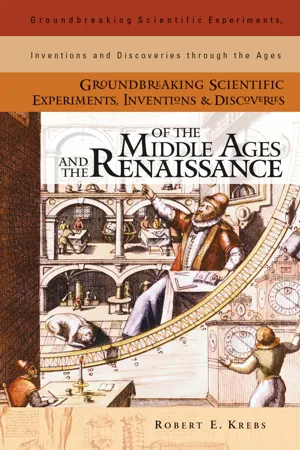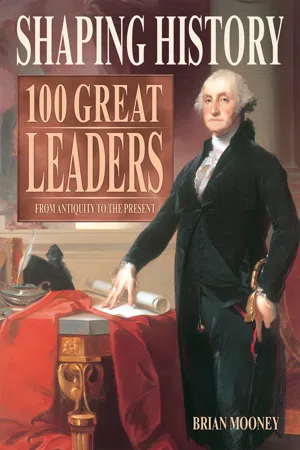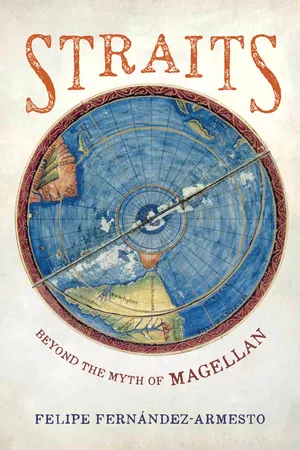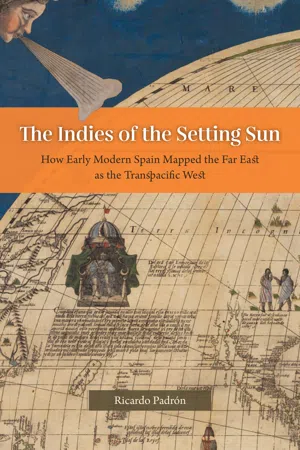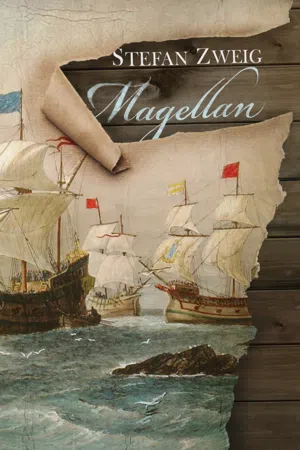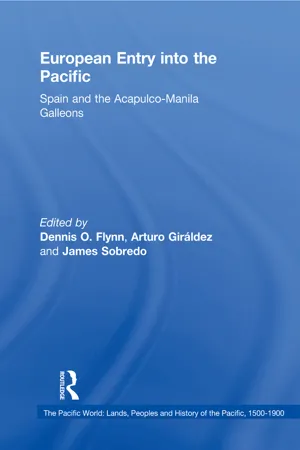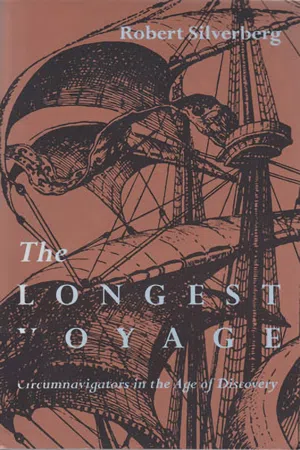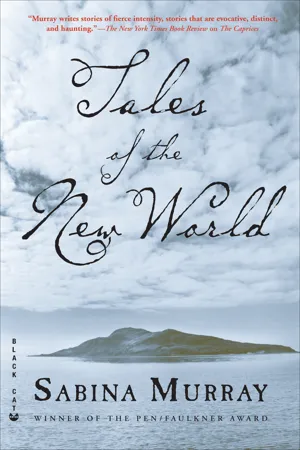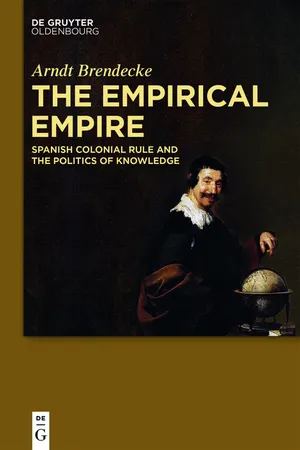History
Ferdinand Magellan
Ferdinand Magellan was a Portuguese explorer who led the first expedition to circumnavigate the globe. In 1519, he set sail from Spain with five ships and eventually reached the Philippines, where he was killed in a battle with local tribes. Although Magellan did not complete the journey himself, his expedition proved that the Earth was round and significantly expanded European knowledge of the world.
Written by Perlego with AI-assistance
Related key terms
11 Key excerpts on "Ferdinand Magellan"
- eBook - ePub
- Robert E. Krebs(Author)
- 2004(Publication Date)
- Greenwood(Publisher)
(This was several years after Columbus’s westward trip to find a passage to the East going the other direction.) Vasco da Gama sailed up the east coast of India to Calcutta in 1498, which, in a sense, completed the goal of Prince Henry to find a sea route to compete with the overland trade. This was the first trip that lasted long enough to cause death to most of the crew as a result of scurvy. • Ferdinand Magellan (1480–1521) was a Portuguese navigator whose fleet of five ships set out on a round-the-world ocean exploration in 1519. Because Spain funded his expedition, Portugal tried to prevent his trip. He eventually set sail westward to find a southern passage to the riches of the Spice Islands, a goal that had evaded Columbus about 25 years earlier. Magellan knew that he must pass the unexplored southern tip of the South American continent, but this was more of struggle than he had anticipated. It required several weeks during storms and high seas to slowly and cautiously pass through these treacherous straits, now called the Strait of Magellan. After passing the tip of South America he entered the open, calm, great new body of water that he named Pacific, which means “peaceful” or “calm.” It was much larger than he expected, and his fleet sailed for four weeks without sighting land. Many of the crew were in the process of dying of hunger when they finally landed on an island, present-day Guam. After securing food, they continued to the Philippine Islands where natives attacked the party. Magellan died from wounds received in this battle in 1521. The exploration continued westward. Only one of the original five ships, the Victoria, and only 18 men under the command of Juan Sebastian de Elcano made the return trip to Spain in 1522. They managed to arrive with enough spices to pay for the trip and to make a profit. Spain soon gave up the Spice Islands for the more lucrative adventures of collecting Inca gold in the New World - eBook - ePub
Navigations
The Portuguese Discoveries and the Renaissance
- Malyn Newitt(Author)
- 2023(Publication Date)
- Reaktion Books(Publisher)
8
MAGELLAN: THE NAVIGATOR AS EPIC HERO
A great change came over the civilisation of the Renaissance in about the year 1500. This is no longer a world of free and active men, but a world of giants and heroes . . . To the humanist virtues of intelligence was added the quality of heroic will. For a few years it seemed that there was nothing which the human mind could not master and harmonise.KENNETH CLARK , Civilisation1I t seems now almost inevitable that the period of the Renaissance, in which the appreciation of classical literature was reborn and the seas of the world were explored for the first time, should have produced its own counterpart to the Odyssey of Homer, its own great maritime epic. For it is only in this way that the great voyages of Vasco da Gama and Ferdinand Magellan can be fully understood. These voyages are two of the most significant events that contributed to a new scientific understanding of the world and at the same time they set in motion a process that was to enable the states of western Europe to dominate the maritime spaces of the world and ultimately the world economy up to the twentieth century.Vasco da Gama and Magellan’s Voyages as Epics
The facts of the two voyages are well enough known and have often been recounted, but factual accounts alone do not seem to be sufficient for an understanding of the human dimension and writers have turned to epic literature fully to explain their significance. Epics, it has been argued, are the form of cultural expression typical of a society ‘dominated by a powerful and warlike nobility, constantly occupied with martial activities, whose individual members seek, above all, everlasting fame for themselves and for their lineages’.2 - eBook - ePub
Shaping History
100 Great Leaders
- Brian Mooney(Author)
- 2012(Publication Date)
- Arcturus(Publisher)
San Antonio , Magellan now summoned all his strengths of leadership and courage to drive the fleet on. His men, racked with scurvy and thirst, were reduced to chewing boiled leather and eating rats before they reached Guam on 6 March 1521, their first land for ninety-nine days.Magellan sailed on to the Philippines, becoming the first European to reach the islands, and then foolishly engaged in a local war on behalf of the ruler of Cebu. He was killed by a poisoned arrow while attacking the island of Mactan.Two of his surviving ships continued to the Spice Islands, where they loaded up with valuable cargo, and one of them, the Victoria , completed the circumnavigation of the globe round the Cape of Good Hope, and berthed back in Seville on 9 September 1522. Her cargo of spices alone paid for the expedition, but she had just eighteen European and four Indian survivors.MONTE VIDEO !•The Uruguayan capital Montevideo acquired its name from Magellan’s voyage. The hill on which it was built came into sight as his ship probed the River Plate estuary. ‘Monte video’ (I see a hill), Magellan shouted.•Sailing through the Magellan Strait that is named after him, Magellan’s crew sighted fires burning on the shore. They were lit by native hunters, and the Spanish sailors called the place Tierra del Fuego – Land of Fire.• When Magellan’s fleet emerged into open water, his men were so relieved to find calm sea that they named the ocean ahead of them the Mare Pacifico, the Pacific Ocean.• Magellan’s name in Portuguese is Fernão de Magalhães; in Spanish, Fernando de Magallanes.• An Italian crew member Antonio Pigafetta kept a diary of the entire voyage around the world – a key source of our information on this epic journey.HERNÁN CORTÉS
Hernán Cortés (1485–1547) was a Spanish explorer who led a tiny army that conquered the mighty Aztec Empire in Mexico. His military daring ensured an astonishing victory that inspired others to invade lands in search of riches throughout Central and South America. - eBook - ePub
Straits
Beyond the Myth of Magellan
- Felipe Fernandez-Armesto(Author)
- 2022(Publication Date)
- University of California Press(Publisher)
CHAPTER 1The Globe around Magellan
The World, 1492 to 1521
And the channels of the sea appeared, the foundations of the world were discovered, at the rebuking of the Lord, at the blast of the breath of his nostrils. —2 Samuel 22:16FIGURE 1. The Indian Ocean, where Magellan’s overseas adventures began in 1505, was the world’s richest arena of commerce at the time. Until the 1490s most fifteenth-century European maps of the world showed the Indian Ocean as enclosed and inaccessible from Europe by sea, thanks to the influence of the Geography of the revered second-century Alexandrian cosmographer Claudius Ptolemy. Interpretations of his text informed most educated Europeans in the late fifteenth century, as in this example, reproduced, from a model of the 1480s, in Sebastian Münster’s Cosmographia , which appeared in successive editions in the 1550s, showing the ocean surrounded by enveloping lands. Putti blow winds onto the world from a cloudy firmament. Magellan retained elements of Ptolemy’s image, including the peninsula, here marked “India extra Gangem,” to the east of India, and the island of Taprobana, corresponding roughly to modern Sri Lanka. Spanish cosmographers claimed that the meridian of the great bay marked “Sinus Gangeticus” marked the dividing line between zones of navigation agreed upon by Spain and Portugal. Courtesy of the James Ford Bell Library, University of Minnesota.“Write what you know,” said Robert Graves, who rarely observed the maxim. It has become a shibboleth for writing teachers but seems contemptible: facile, challengeless, narrow-minded, anxious for success. The unknown is magnetic: an invitation to endlessly unwinding problems, a lure to the receding horizon that seduced Magellan, or a way into the improbable stories he composed for himself in his head and tried to act out in his life. In sticky, smelly classrooms, amid Gradgrind-mark schemes and marginal ticks, history is “about facts.” But, for me, facts are there only to feed problems: insoluble problems—for preference—that flirt and flit as you grasp at them. - eBook - ePub
New Found Lands
Maps in the History of Exploration
- Peter Whitfield(Author)
- 2015(Publication Date)
- Routledge(Publisher)
Vittoria dropped anchor outside Seville, with fewer than twenty survivors of this extraordinary voyage.Magellan’s energy and vision equalled that of Columbus, and he shared with his great predecessor the tenacity of a man driven by something deeper than common ambition. What Magellan’s personal drive was we can only guess at, since no personal statement of his aims and beliefs survives, but a desire for revenge against the country that had spurned him must have played its part in forging his implacable determination to destroy the Portuguese monopoly in the spice trade. Ultimately other historical forces accomplished this aim, for the immensity of the Pacific meant that there were few immediate results for Spain from Magellan’s achievement. But he dispelled two beliefs that had been widely held in Europe during the immediate post-Columbus era: that there was an easy way to penetrate the barrier of the Americas, and that, once a way had been found, the Indies and Cathay were within easy reach. The subsequent quests for the North-East and North-West Passages would demonstrate that European geographers failed to absorb the lesson of the Magellan’s Pacific voyage and what it showed about the size of the earth.In the wake of Magellan, at least four Spanish expeditions crossed the Pacific seeking to establish a Spanish route to and presence in the Spice Islands, and most important of all, a return route to Central America, which would enable Spain to conduct its own eastern trade. Del Cano himself sailed from Spain in 1525 with Garcia de Loyasa and a considerable fleet of seven ships on a disastrous voyage in which only two vessels survived the crossing to the Moluccas, both Del Cano and Loyasa dying at sea. On a second ill-fated enterprise, Hernan Cortes dispatched three ships from Mexico in 1527 commanded by Alvaro de Saavedra. Despite having halved the sailing distance and having found a favourable route at around latitude ten degrees north, only one ship made port in the Moluccas, where Saavedra joined forces with the survivors of Loyasa’s fleet, and attempted the first west-east crossing of the Pacific, back to America. The prevailing easterly winds in the central Pacific completely defeated the Spanish and forced them back to the Moluccas, though not before they had touched the northern coast of New Guinea, which was to become a major, if enigmatic, feature on the Pacific map. - eBook - ePub
The Indies of the Setting Sun
How Early Modern Spain Mapped the Far East as the Transpacific West
- Ricardo Padrón(Author)
- 2020(Publication Date)
- University of Chicago Press(Publisher)
3Pacific Nightmares
On November 28, 1520, the fleet commanded by Ferdinand Magellan exited the strait that now bears his name and entered the waters of what he himself christened the Pacific Sea. Having discovered the maritime passage through the New World, Magellan believed he had met the most difficult challenge facing his expedition, and that the Spice Islands, his ultimate objective, could not be more than a few weeks away, across a relatively narrow ocean dotted with islands potentially rich in spices, gold, silver, and precious stones. Yet rather than island-hop his way to the Spicery in short order, he found himself sailing for months across vast tracks of featureless ocean, encountering only two desolate, uninhabited islets along the way. The ships did not make any significant landfall until March 6, 1521, when they raised an island in the Marianas group, most likely Guam, the crew starving, thirsty, and wracked by scurvy. Eighteen months later, the expedition’s sole surviving vessel, the Victoria, limped into Seville carrying a cargo of cloves and a small group of emaciated survivors, the expedition’s commander lost in combat with the indigenous inhabitants of what would later come to be known as the Philippines. It brought the surprising news that the ocean between the New World and the Spicery was much broader and emptier than anyone had expected it to be.The historiography of exploration often identifies this revelation as Magellan’s “discovery of the Pacific,” and argues that it had a significant impact on European ideas about the world’s geography (Bourne 1904, 132; Basch et al. 1962, 248; Parry 1974, 258; Morison 1971, 2.466). Simply put, the discovery of the Pacific made it more difficult to believe that what we call North America was part of Asia, and thus it helped consolidate the invention of America. In making this argument, historians of exploration and discovery often point to the surviving manuscript planispheres produced during the 1520s at Seville’s Casa de la contratación, utilizing privileged information drawn from the logbooks of the Magellan expedition, which the crown did not allow to circulate outside official circles.1 A large empty space opens up west of the New World on these charts, testifying to the surprising distance that the fleet had to sail to reach the Spicery from the Strait of Magellan, and presumably, to the uncharted dimensions of the Pacific Ocean. The distance ranges from 120° of longitude between Peru and the Spicery on the anonymous planisphere of 1523, to 130° on the famous 1529 planisphere by Diogo Ribeiro, but it is invariably greater than the distance that had appeared on any previous map, even those made in Seville (see fig. 7 ).2 Historian J. H. Parry lauds this particular planisphere for its apparent “completeness,” and he offers it as an example of how the discovery of the Pacific brought “received ideas” about the world’s geography, most of them stemming from Ptolemy, crashing to the ground (1974, 260).3 - eBook - ePub
- Stefan Zweig, Eden Paul, Cedar Paul(Authors)
- 2011(Publication Date)
- Pushkin Press(Publisher)
In anticipation of England’s political ideas, he was to occupy the places of ingress to and egress from all inland seas, block the chief straits from Gibraltar to Malacca, close the southern inlets from the Red Sea and the Persian Gulf into the Indian Ocean, which was to be made impracticable for any maritime traffic other than that of Portugal. He had also received instructions to annihilate the sea power of the Sultan of Egypt and of the Indian rajas, was to keep the Eastern ports under such strict control that from the year of Our Lord 1505 no ship unprovided with a Portuguese licence could take on board so much as a peppercorn. In pursuance of these military and naval schemes, he was to spread Christianity in the countries he would conquer—this plan giving his expedition the character of a crusade. With his own hand, in Lisbon Cathedral, the King gave Dom Francisco de Almeida a new banner of white damask bearing in crimson satin the Cross of Christ, and this banner was to wave victoriously over the lands of the Moors and other pagans. The admiral knelt to receive the sublime emblem, and there knelt with him fifteen hundred of his men who had confessed their sins and received the Host, taking an oath of fidelity to their earthly lord, the King of Portugal, as well as to their heavenly master, whose realm was to overcome that of the foreign unbelievers. From the cathedral they marched in solemn procession to the harbour. The guns thundered farewell. Magnificently, then, the ships sailed down the Tagus into the open sea which the admiral had vowed to conquer for Portugal as far as the ends of the earth. Among the fifteen hundred who, with bowed heads, had knelt before the altar, and with uplifted hands had taken the oath of loyalty, was a man of twenty-four, Ferdinand Magellan, who had not as yet made a name in the world. Of his origin little more is known than that he was born about the year 1480, his very birthplace being open to dispute - eBook - ePub
European Entry into the Pacific
Spain and the Acapulco-Manila Galleons
- Dennis O. Flynn, Arturo Giráldez(Authors)
- 2017(Publication Date)
- Routledge(Publisher)
(vol. 3, Fernando de Magallanes, includes a very useful biography, bibliography, and reprinting of documents and extracts from early historians, as well as a few "new" documents); George E. Nunn: "Magellan's route in the Pacific," Geogr. Rev., vol. 24 (4), pp. 615-633, New York, 1934 (a stimulating discussion, with good listing of basic sources); Stefan Zweig: Magellan, pioneer of the Pacific, London, 1938, 311 pp. (original German edition... Magellan, dermann und seine tat, Wien, 1938, 370 pp.) is romantic and personalized; Visconde de Lagôa:. . . Fernão de Magalhãis..., Lisboa, 1938, 2 vols, (the most scholarly study of Magellan to date; vol. 1 contains the life of Magellan and vol. 2 is a detailed study of the voyage based on all known sources); Enrique Ruiz-Guiñazú: Proas de España en el mar magallánico, Buenos Aires, 1945, 170 pp. (a partisan pro-Elcano text primarily concerned with Argentine waters and with Spanish discovery of the Falkland Islands but useful for the map reproductions); Amando Melón y Ruiz de Gordejuela; "Los primeros tiempos de la colonización. Cuba y las Antillas. Magallanes y la primera vuelta al mundo," Historia de América, vol. 6, pp. 1-748, Barcelona, 1952 (typical of the pro-Elcano nationalistic school of writers); Charles McK. Parr: So noble a captain; the life and times of Ferdinand Magellan, New York, 1953, 423 pp. (romantic and pro-Magellan, with a list of Magellanic transcriptions from the Archivo General de Indias, Sevilla). 17. Probably three-masted two-decked ships, square rigged (veins redondas) on the foremast and mainmast, and triangular-rigged (vela latina) on the mizenmast. As implied in note 7, there is no contemporary description or representation of the Victoria or of any of the other sailing ships. The ships depicted on various charts, such as the one by Ribero in 1529, are generalized inventions of the cartographer. 18. It is impossible to convert these tonnages accurately into modern tonnages [note 8] - eBook - ePub
The Longest Voyage
Circumnavigators in the Age of Discovery
- Robert Silverberg(Author)
- 2020(Publication Date)
- Ohio University Press(Publisher)
Juan Serrano, though, did not feel competent to undertake the quest of the Moluccas. He nominated instead his cousin, Ferdinand Magellan, who—next to his own brother Francisco Serrão—was the man most familiar with Moluccan waters. The nomination was seconded by Barbosa’s son, Duarte, who had known Magellan well in India. The elder Barbosa proposed Magellan’s name to Bishop Fonseca, who knew nothing at all of Magellan but who was willing to accept Barbosa’s recommendation. It was time now to let Magellan know of all this: Duarte Barbosa, who, like his father, had been living in Spain, made a secret visit to Oporto to find out if Magellan would accept the assignment. Magellan, of course, accepted most readily, making only the stipulation that his friend, the wild-eyed astronomer Ruy Faleiro, be taken into the project as an equal partner. Duarte Barbosa, aware of Faleiro’s high reputation as an astronomer and unaware of his personal eccentricities, agreed to this and told Magellan to come to Seville as soon as possible to consummate the arrangement. The expedition was not yet a certainty; Fonseca, powerful as he was, would have to win the backing of King Charles and certain Spanish officials before the ships could go to sea, and there was also the little matter of financing the venture. But the prospects were good. In the autumn of 1517, Magellan, accompanied by his Malayan slave Henrique, left Portugal behind forever and took ship for Spain.Bishop Fonseca was not the only great man of his day interested in finding the western route to the true Indies, though. The wily Cristóbal de Haro, Portuguese agent for the vast Fugger interests, had independently been seeking the same thing since the turn of the century; and now, when all roads suddenly led to Spain, Haro’s schemes and Magellan’s destiny converged.Haro, though a Spaniard, had been the Fugger man in Lisbon since 1486. He had not been able to win a place in the social life of King João II’s court, probably because he came from a family of Christianized Jews, but his skill as a financier had given him access to the inner circles of the Portuguese administration. Haro had invested Fugger money in the early voyages to Africa and around the Cape of Good Hope and had been consolidating his position when João II died in 1495. Under King Manoel, Haro’s situation had been more precarious; at first excluded from influence by Florentine rivals, he had regained his earlier importance by the sheer power of Fugger gold. Not only did Haro and the Fuggers underwrite the costs of the royal spice fleets, but they developed their own export-import organization, with fifteen swift square-rigged naos - eBook - ePub
Tales of the New World
Stories
- Sabina Murray(Author)
- 2011(Publication Date)
- Black Cat(Publisher)
There were many things that Magellan would have to answer for upon reaching Spain. First among these was his stranding of Cartagena, the Spaniard and nobleman, back in Patagonia; he’d replaced him with another relative, Mesquita, whose fittedness—beyond blood—was that he hadn’t the skill to sail, thus no will to rebel. Magellan was hated for being Portuguese, but once he drew near to the Moluccas, it would be the Portuguese—protecting their stake in the Spice Islands—who would give him the most to fear. And there was the San Antonio, presumed back in Spain and slandering. Once again he would be forced to defend himself, and why? Because he was the greatest explorer! He, Ferdinand Magellan, had the whole world: his seas and lands rolled out before him; his march into creation; this track always slouching off to the west and west; the eternal conquering of diminishing distance and unreachable point. The king had only his red carpet and slippered foot upon it. Yes, greatness was something to be feared—his greatness! But to be feared by a king was also something to be feared. And that was if he managed to bring the ships back: who knew what lay hidden by the wall of horizon, crouching in the shade of the unknown? The explorer raked through his beard with his fingers, his head tilted, about to say something—even opening his mouth!—but then, thinking better, resorted to a vague nodding and frowning. “I have something that will cheer you,” said Pigafetta. “You talk with such confidence, Antonio, as if I am looking for cheer, or peace, or happiness—all these things that men want. I am not a man like other men are men. But not like you either.” “Not peace then. Not cheer.” Pigafetta went to stand by the explorer and steered him into the night sky. There were two shreds of cloud—star cloud—as if they had torn off the Milky Way and caught upon some distant, galactic bramble. “Do you see the clouds?” “Yes,” said Magellan. “Is that something new?” “New or old, it does not matter - eBook - ePub
- Arndt Brendecke(Author)
- 2016(Publication Date)
- De Gruyter Oldenbourg(Publisher)
IntroductionLet us begin with a scene that took place in 1518 at the Spanish court. Two Portuguese men, a cosmographer and a seafarer, requested an audience with the eighteen-year-old King Charles. They were initially admitted to see his grand chancellor, Jean Sauvage, and later to see the king himself. The seafarer had in his hands a “beautifully painted globe” on which he was using his fingers to trace the route he wanted to sail. The seaman was Ferdinand Magellan, and he wanted to convince the court and the Spanish king (the future Emperor Charles V) that the American continent could be penetrated via a navigable passage. Through this passage one could reach the Pacific, travel to the Molucca Islands, take possession of them for the Spanish king, and finally sail around the world. Only a short time later royal privileges were issued. The ships sailed under the Spanish flag. King Charles and his advisers had apparently been persuaded. And this was the case even though there was nothing that could be seen on the globe, for the cosmographer, Rui Faleiro, and Magellan had left the critical spot blank, marked only in white. Only the rest of the globe, the world already known, was “beautifully painted.”1We cannot say what the king really knew and why he made the decision he did. But, precisely because he was a king, it is possible to reconstruct with relative precision how he became informed and to which media, people, and institutions he could resort in order to keep himself informed. In this book I take advantage of this circumstance as I attempt to observe tangible relations between information and the exercise of sovereignty. In so doing, however, we need to be aware of how contemporaries were already cognizant of knowledge as a political issue. None of these scenes is free of assessments. The anecdote about the scene at court, for example, is only known to us by way of Las Casas’s Historia de las Indias
Index pages curate the most relevant extracts from our library of academic textbooks. They’ve been created using an in-house natural language model (NLM), each adding context and meaning to key research topics.
